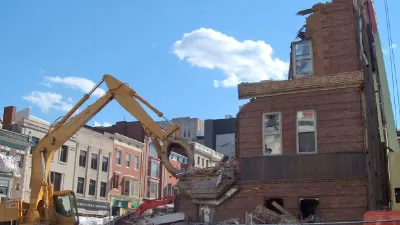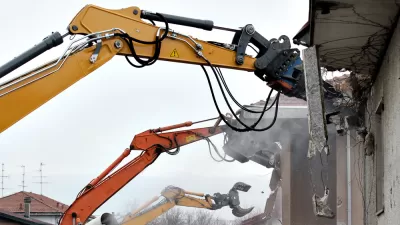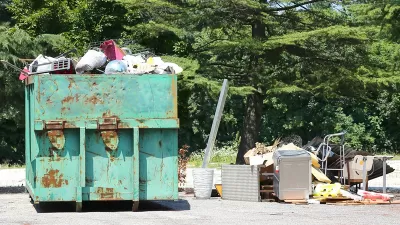Data regarding ongoing demolitions of blighted properties in cities across the U.S. has turned up some unexpected consequences: the spread of lead toxins into the surrounding community.

Eilís O’Neill of The Nationreports on the potentially devastating environmental consequences of blight removal. Older homes being demolished will often contain lead-based paint that when released into the atmosphere can be inhaled and absorbed into the bloodstream of children nearby. Studies have shown the harmful impacts of elevated lead in the bloodstream of infants, including " learning disabilities, speech delays, hearing loss, lowered IQ, and increased hyperactivity and aggression."
In cities, such as Detroit, where removal of older homes is an ongoing process, children in the vicinity of the demolition are now showing elevated blood-lead levels.
...in 2016, according to the Michigan Department of Health and Human Services, the city’s blood-lead levels spiked. While this unsettling uptick coincided with increased testing of vulnerable populations, some critics say the sharp increase can’t be attributable to testing alone, and that the city is removing lead with one hand while adding it back with another.
For these critics, the blame for the spike lies with a federally funded “blight removal” program that is perhaps the biggest housing-demolition program in history.
O'Neill reports that currently there are three demolition strategies in use: the dry method which is the quickest and easiest, but tends to kick up the most dust; the wet-wet protocol, which includes wetting the house during the demolition process to keep most of the dust contained to within 350 feet of the site; and the newer Baltimore protocol, which covers the house in plastic and keeps the house wet with multiple hoses throughout the demo process. The Baltimore protocol has been shown to limit dust exposure to approximately within 60 feet of the demo site.
FULL STORY: Are We Doing All We Can to Prevent Lead Poisoning?

Planetizen Federal Action Tracker
A weekly monitor of how Trump’s orders and actions are impacting planners and planning in America.

Map: Where Senate Republicans Want to Sell Your Public Lands
For public land advocates, the Senate Republicans’ proposal to sell millions of acres of public land in the West is “the biggest fight of their careers.”

Restaurant Patios Were a Pandemic Win — Why Were They so Hard to Keep?
Social distancing requirements and changes in travel patterns prompted cities to pilot new uses for street and sidewalk space. Then it got complicated.

San Francisco Suspends Traffic Calming Amidst Record Deaths
Citing “a challenging fiscal landscape,” the city will cease the program on the heels of 42 traffic deaths, including 24 pedestrians.

California Homeless Arrests, Citations Spike After Ruling
An investigation reveals that anti-homeless actions increased up to 500% after Grants Pass v. Johnson — even in cities claiming no policy change.

Albuquerque Route 66 Motels Become Affordable Housing
A $4 million city fund is incentivizing developers to breathe new life into derelict midcentury motels.
Urban Design for Planners 1: Software Tools
This six-course series explores essential urban design concepts using open source software and equips planners with the tools they need to participate fully in the urban design process.
Planning for Universal Design
Learn the tools for implementing Universal Design in planning regulations.
Heyer Gruel & Associates PA
JM Goldson LLC
Custer County Colorado
City of Camden Redevelopment Agency
City of Astoria
Transportation Research & Education Center (TREC) at Portland State University
Camden Redevelopment Agency
City of Claremont
Municipality of Princeton (NJ)





























